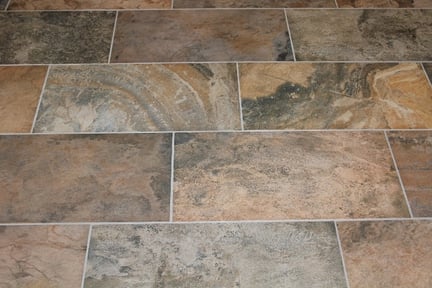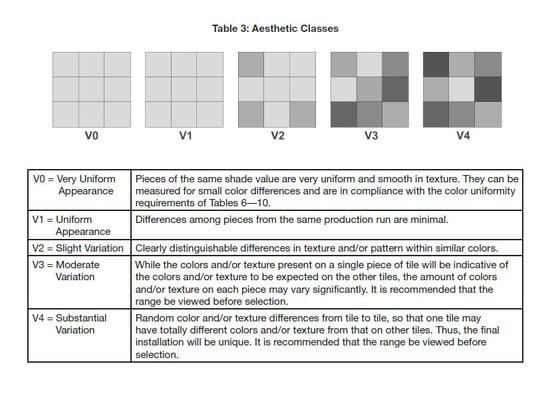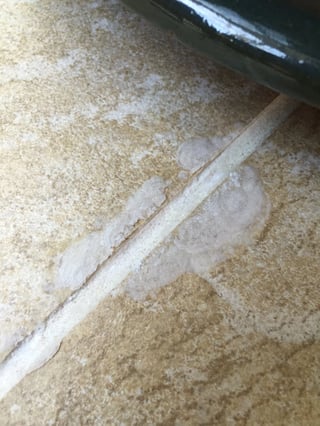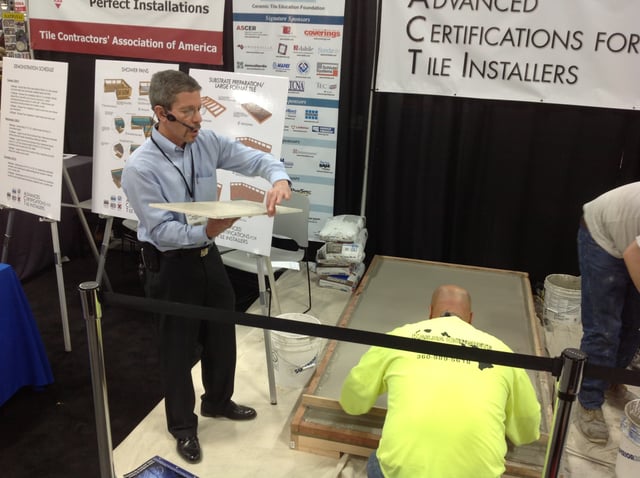A Homeowner's Guide to Hiring a Qualified Tile Installer
Looking for Guidance on How to Select a Tile Contractor?
The Ceramic Tile Education Foundation has just the guide you need! It's the Homeowner's Guide to Hiring a Qualified Tile Installer.

The operational word is 'qualified' so you end up with exactly the tile installation you have in mind and it performs as it should.
In this 31-page guide, we've included:
- Our top tips for hiring a tile installer
- Information on what goes into a high-quality tile installation
- Common tile installation problems that qualified contractors know how to anticipate
- What to do if you encounter major problems
- And more.
To download the Homeowner's Guide to Hiring a Qualified Tile Installer, simply complete the form.
Note:
You can also view the entire guide below. Use the Table of Contents to browse and jump to different sections in the guide.

The Homeowner's Guide to Hiring a Qualified Tile Installer
Table of Contents
Introduction
Chapter 1 - Hire Qualified Labor for Your Tile Installation Project
Chapter 2 - Best Practices for Hiring a Tile Installation Contractor
Chapter 3 - What Makes a High-Quality Tile Installation
Chapter 4 - What Tile Installation Standards and Guidelines Exist?
Chapter 5 - Common Tile Installation Problems
Chapter 6 - A Solution to Those Problems: Tile Installation Mockups
Chapter 7 - How to Deal with Major Installation Problems?
Chapter 8 - The Problem of Efflorescence
Chapter 9 - For the Installer: What's the Certified Tile Installer Program?
Chapter 10 - Next Steps

Introduction to the Guide to Hiring a Qualified Tile Installer
Welcome to the Homeowner's Guide to Hiring a Qualified Tile Installer.
We realize that hiring a tile installer can present challenges.
After all, you want to bring a vision to life. Most probably, you're looking for a ceramic tile installation professional who will take the beautiful tiles you painstakingly selected and transform them into the floors or walls of your dream-come-true space. As visual as tile is, when it's installed it also needs to be functional.
Evaluating experience and knowledge can be difficult if you're not in the tile installation business day in and day out. And when you aren't sure, it's easy to fall back on using the lowest price or bid to evaluate who to hire which brings its own set of problems.
In this guide, we'll explain what to look for, so you hire a qualified installer who will bring that vision to life.
We'll highlight the references and resources to which professional installers or setters refer, the organizations they belong to, along with the common best practices and areas of concern.
We'll conclude with next steps.

Chapter 1: Hire Qualified Labor for Your Tile Installation Project
For your tile installation project, you want someone who has experience and knowledge of how to install tile correctly, without taking shortcuts, while ensuring that the final installation looks beautiful and performs as it should long after that installer is gone, someone with the proper skill level to do it right the first time.
You want to hire Qualified Labor.
What Does Qualified Labor Mean?
Qualified labor refers to having the most qualified professional perform the scope of the work you are specifying rather than basing the decision on the lowest price.
The Tile Council of North America (TCNA) Handbook committee strongly recommends using installers who have demonstrated their commitment to their craft and taken the time to stay current with the latest materials and methods. Because tile is a permanent finish, the lowest bid should not be the driving factor, but rather who is the most qualified to perform the scope of the work specified.
The Handbook further defines Qualified Labor being provided by the following non-profit organizations and programs:
- The Advanced Certifications for Tile Installers (ACT),
- The Ceramic Tile Education Foundation (CTEF),
- The International Masonry Institute (IMI) Contractor College Program,
- Journeyman Tile Layer Apprenticeship Program,
- The Marble Institute of America (MIA) Accreditation for Natural Stone Tile Installation Contractors,
- The National Tile Contractors Association (NTCA) Five Star Contractors Program,
- The Tile Contractors’ Association of America (TCAA) Trowel of Excellence Program.
From a technical perspective, qualified labor means having successfully demonstrated a tile installer's skills that meet tile industry standards and best practices. That is what the Certified Tile Installer (CTI) program does. The CTI designation identifies the professional installer who has reached a level of proficiency to independently and consistently produce a sound tile installation that displays good workmanship. It is the only third-party assessment of tile experience and knowledge.
Certified Tile Installers routinely demonstrate the knowledge, skill, experience, time management abilities and other traits needed to produce high quality, long lasting, successful installations using Tile Industry standards and methods along with time-tested proven best practices which are in place in the United States.
Any installer may take the Certified Tile Installer (CTI) exams if he or she has at least two years of experience as the lead installer setting ceramic tile on a full-time basis. That means having full responsibility for substrate prep, layout, coordinating with other trades along with properly installing underlayment, tile, grout and sealant materials.
Be concerned if the only experience is as a helper, improver, grouter, finisher, or another entry-level support role. That isn't enough.
Where Can You Find Tile Installation Experts For Your Project?
To find qualified labor, look for tile installation certifications such as,
- Certified Tile Installers: CTIs are ceramic tile installation professionals who have successfully passed industry approved written and hands-on tests for the proper installation of tile. These installers have the knowledge and skills to install your tile using current tile industry best practices, while adhering to industry approved standards.
- ACT Advanced Certifications for Tile Installers: ACT Certified Tile Installers have specific certifications in tile installation procedures that meet current ANSI standards and TCNA guidelines for floor and walls. To qualify to take these advanced tests, ACT Certified Installers must have either successfully completed a Department of Labor approved apprenticeship program or have passed the CTI - Certified Installer test offered by the Ceramic Tile Education Foundation (CTEF). ACT Certified Installers represent the pinnacle of performance in the tile trade and maintain a level of excellence superior to non-ACT certified installers.
Look for installers and tile contractors who are members of accredited tile industry organizations such as the National Tile Contractors Association.
All NTCA Contractor members, whether they are Five Star Contractors, Certified Tile Installers, Advanced Certified Tile Installers, or regular Contractor members, have access to the most current and accurate tile installation standards and methods available.
NTCA members have access to live technical assistance from the NTCA Technical Experts which is invaluable in cases where trouble-shooting and problem-solving are required. These experts each have over 30 years tile installation and project management experience, while also being members of many industry technical and specification committees involved in creating the industry standards for all types of tile installations.
Look for NTCA special member designations and recognitions.
 More specifically, NTCA Five Star Members have completed and been approved for acceptance into a strong association accreditation program. They have been NTCA members for over three consecutive years, have an active safety program, and are committed to continuing education, training and certification for their installers.
More specifically, NTCA Five Star Members have completed and been approved for acceptance into a strong association accreditation program. They have been NTCA members for over three consecutive years, have an active safety program, and are committed to continuing education, training and certification for their installers.
In the Five Star applications process, these contractors must provide formal recommendations from their customers, suppliers, and peers in the tile installation industry. They are also required to employ Certified Tile Installers.
Find Certified Tile Installers
For Your Project!

Chapter 2: Best Practices for Hiring a Tile Installation Contractor
Step 1: Identify the Tile Installers You Want to Interview
Select and interview at least three tile contractors.
>> Here's a 5 page questionnaire CTEF has developed with questions to ask your contractor about your project, the contractor's qualifications, experience and their employees.
You want to understand who will be doing the work, whether your choice is in compliance with insurance, liability, workman's comp, any applicable state licenses, and local codes. The tile installer you hire should welcome your questions and the opportunity to demonstrate his or her qualifications.
Here's interesting perspective from a comment on Why Do You Need Expansion Joints When Installing Tile? Rick says,
"... When you go into an estimate you must be armed with knowledge and have with you the proof of that knowledge. You must be licensed, certified, insured and have proof of that along with the literature that proves what you are trying to convey to your customer. You may be the only one explaining that it is necessary to install expansion joints however if you backup what you are explaining with the proper credentials and literature they will not only believe you, but you will get the job.
I leave a copy of my license, any certifications, and liability insurance with every estimate that I give. Also, if a customer would like references, I leave them a copy of every customer that I have confirmed with and explained to about this list with that new potential customer.
After you complete a job you ask the customer if they could be put on a referral list in which they could receive a call from a potential customer. Some people like their privacy and I respect that, however most people will agree to be on the list..."
Step 2: Obtain and Check References
Next, ask for references and do your due-diligence by asking the following types of questions of those references:
- How easy was it to communicate with the installer?
- How well did s/he listen to the homeowner or specifier?
- How pleased is the reference with the quality of the work done?
- Would the reference hire the installer again?
- Would the reference do anything differently?
- What were some of the details of the reference’s installation project?
- Can you see the completed work – either in person or via photos?
- Did the installer show up on time during the project?
- How clean, neat and respectful of the home or job site was the installer?
- Was the project completed on schedule?
- Were final details handled in a timely manner?
- How were unexpected situations handled?
- Did the installer fulfill the terms of the contract?
- How professional, ethical and honest was the installer throughout the process?
- How much did the final price differ from the quoted one?
Pay attention to warning signs
As you proceed through your conversations with your three installers and their references - especially if you cannot confirm that your candidates are Certified Tile Installers - be on the lookout for warning signs.
- Can you verify the installer's contact information?
- Are you being asked to pay cash, upfront before your tile project has started?
- You can't believe how low the price is for your tile installation project!
- Is checking references complete agony?
- Do you feel like you are speaking to a wall?
- Is it impossible to reach your tile contractor by phone?
- Are your tile project requirements being ignored?
- Why can't you see examples of previous tile installation projects?
- Yikes, those are bad online reviews!
- How much experience does that tile installer have?
Step 3: Ask Your Contractor Candidates Questions
You can't ask too many questions. Questions help anticipate issues and ensure a better overall experience and final installation. Here are some possible questions to consider:
- Is my home structurally adequate for tile? For example, if you are replacing vinyl floorcovering with tile and adding a granite countertop, will the structure support the weight?
- Do we need the services of a structural engineer?
- Will there be days when no work is done due to drying or curing time?
- What about my existing floor?
- What if there's existing asbestos, or the painted surfaces contain lead?
- What do you suggest for the transition from the new floor to the adjacent floor?
- How long will I be out of my home/space?
- Who gets the building permit if one is required? (This depends on the code in your area.)
- Will any sub-contractors be included in your bid or are they part of a separate contract?
- Are plumbers, electricians, or other subcontractors all properly licensed, bonded and insured?
Step 4: Ensure You Have a Written Agreement
True qualified labor will follow up with a written agreement.
Detail selections and design options.
If you have any detail work in mind, require that the contractor provide a mockup (a physical example of the tile shade variation, pattern if specified, grout color, grout joint size, and color-coordinating sealant). If you have tile with extreme color variation (i.e., V4), be certain that all parties understand the variations. A mockup helps here, too.
In the tile world, mockups should be used as a tool by the tile contractor to obtain the approval of the owner and possibly also the architect, designer, and general contractor - all important specifier constituents for the end project. Establishing how the finished tile installation will appear before the work begins is a wise choice which can save time and money. A mockup can consist of photos, digital renderings, an installed board or simply laying out a box of the tile on the floor to see the range of color and texture.
>> See Chapter 6 - Mockups below
Set expectations for the tile installation project.
The written agreement sets expectations for payment as well as for scheduling. Make sure there's an allowance for changes and that you have a reasonable completion date.
If the completion date is exceeded, what provisions are in place to handle the delay and who will pay for the extra work?
Find Certified Tile Installers
For Your Project!

Chapter 3: What Makes a High-Quality Tile Installation?
What does it take to ensure that you have a quality tile installation? Based on our experience, knowledge and work with the Tile Council of North America (TCNA) Handbook, we have identified ten requirements.
1. Incorporate Movement Accommodation Joints in the Tile Installation
All tile installations, both residential and commercial, will move with temperature and humidity variations.
To accommodate this expansion and contraction activity, the use of expansion joints per the TCNA Handbook for Ceramic, Glass and Stone Tile Installation method EJ171 must be incorporated into the tile work. As stated in the Handbook,
“The design professional or engineer shall show the specific locations and details of movement joints on project drawings.”
Be certain that all parties involved in the project including the architect, the specifier, the designer, the salesperson and the tile installer know and understand the critical use and placement of expansion joints.
2. Work Only with Premium Materials to Install Tile
The use of premium quality bonding materials is money well spent. The cost to move to a premium material normally is only pennies per square foot.
Tile Industry experts agree this is one of the easiest insurance policies for preventing installation problems. All types of setting materials are available in various performance levels to meet the requirements of the job.
Contact the setting material manufacturer for products with the specific characteristics and performance levels necessary for success.
3. Confirm that the Tile Installation Surfaces are Flat
To provide a flat ceramic or stone tile installation, carpenters, masons, concrete installers, and other trades must meet the tile industry standards for flatness tolerances.
If substandard surfaces are encountered, they must be corrected before installation begins. Otherwise, you will not have a quality tile installation.
4. Verify that the Tile Installation Surface is Rigid
Ceramic tile installations require a stiff or rigid surface. In some cases, installations, including natural stone, may require additional subflooring, wall studs or bracing. Realize that the substrate for natural stone tile installations must be twice as rigid as that for a ceramic or porcelain tile installation.
The additional subflooring most likely will raise the level of the tile floor above those of adjacent flooring materials. This difference should be addressed and become mutually agreeable before installation begins. A mockup will be helpful in this process.
Tile contractors should follow the applicable recommendations of the TCNA Handbook for Ceramic, Glass and Stone Tile Installation, the ANSI (American National Specifications for the Installation of Ceramic Tile) as well as the recommendations of the manufacturer’s products being used in the project.
5. Minimum Mortar Coverage Must Be Provided
Tile industry standards require minimum mortar coverage of 80% in dry areas and 95% in wet (showers) or exterior areas. Natural stone tile installations require 95% coverage in all applications.
This refers to the contact area of the bonding material (thin-bed mortars, large and heavy tile mortars or epoxy adhesives) with both the back of the tile and the surface being tiled.
Never allow the tile installer to use the five spot or spot bonding installation “trick” on any surface. Spot bonding most times leads to broken and hollow-sounding tiles.
6. Ensure You Have the Minimum Grout Joint Size and Offset
The minimum required joint width for ceramic, porcelain, and natural stone tiles is 1/16”. For installations using running bond/brick joint patterns, either square or rectangular tiles, with any side greater than 15”, the grout joint shall be, on average, a minimum of 1/8’ for rectified tiles and a minimum of 3/16” for calibrated (non-rectified) tiles.
Tiles which are not precisely the same size from tile to tile will necessitate larger grout joints to better disguise variances and therefore present an overall uniform appearance.
Installations calling for any offset tile patterns (non-continuous grout joints), using tiles either square or rectangular, where the side being offset is greater than 15”, the offset pattern will be a maximum of 33% (as seen below) unless otherwise specified by the tile manufacturer.

7. Ensure that Tile Site Conditions Are Controlled
Jobsite environmental conditions can have a serious impact on the success or failure of a tile installation.
Many products used in tile installations require that the temperature and humidity be maintained within a specific range and duration. Be certain to follow the manufacturer’s guidelines to ensure a long-lasting installation.
8. Use Only the Correct Tile Installation Methods and Materials
Not all installation methods and/or materials are suitable for all applications. Be certain that your contractor will use the TCNA Handbook method rated for the intended application or a method that is recommended, fully specified, and warranted by the product manufacturer.
Research manufacturer’s websites to determine suitability, application recommendations and product warranty information.
Review the manufacturer’s product data sheets and recommendations for the tile, backer board, bonding materials, membranes, and grout which will be used on the job.
Just because a product is available doesn’t mean that it is appropriate for a given installation.
9. Allow for Adequate Cure Time
Allow a tile installation to cure sufficiently per the manufacturer's recommendations before exposing it to moisture, traffic, temperature changes or overlaying products. Otherwise it will not perform as a quality tile installation.
The amount of time required will vary based on site conditions and the specific materials being used.
10. Make Use of Crack Isolation Membranes as Needed
Cracks in concrete and other areas of movement should be treated with a crack isolation membrane to help eliminate cracked tiles.
Check with the membrane manufacturer for specific use and application recommendations.
Download 3 Tip Sheets:
How to Select Your Next Tile Installation Contractor
Chapter 4: What Tile Installation Standards and Guidelines Exist?
If you're having porcelain tile installed and you're looking for confirmation or validation that the project will be completed correctly, where do you go?
The tile industry takes seriously its standard-setting role and its commitment to encouraging and supporting installer skill and knowledge. That's why the Tile Council of North America (TCNA), the National Tile Contractors Association (NTCA), the Ceramic Tile Distributors Association (CTDA) among others and the Ceramic Tile Education Foundation (CTEF) exist:
To provide guidelines, education and certification for correctly installing porcelain tile, always refer to these organizations for guidance.
Tile is beautiful, versatile, easily maintained, and it has a rich history. It is also a practical product which must be installed correctly.
It's helpful to know where to find installation resources so you can comprehensively evaluate your installer's skill and knowledge before he or she is hired to complete your dream installation.
ANSI and TCNA Handbook
Here are the primary tile industry standards, methods and guidelines used for the proper installation of ceramic, porcelain, glass, and stone tiles.
- American National Standards Institute (ANSI) A108 and A118 - American National Specifications for the Installation of Ceramic Tile - Material and Installation Standards
- ANSI A137.1 - American National Standard Specifications for Manufacturing Ceramic Tile
- Tile Council of North America (TCNA) Handbook for Ceramic, Glass, and Stone Tile Installation
These standards and guidelines are extensive in that they cover many types of installations using proven best practices, methods, techniques and materials recommended for a variety of structures and substructures.
For example, ANSI A108 defines the acceptable lippage (a condition where the edge of a tile is higher than that of an adjacent tile, giving the finished surface an uneven appearance) for installed Pressed Floor and Porcelain Tile that has been tested and passed the required minimum standards for ceramic tile (found in ANSI A137.1) as follows:
- All sizes of Pressed Floor and Porcelain Tiles with grout joint widths of 1/16” wide to less than 1/4” wide: Allowable lippage is 1/32”.
- All sizes of Pressed Floor and Porcelain Tiles with grout joint widths of 1/4” wide or greater: Allowable lippage is 1/16”.
For reference: 1/32” is roughly the thickness of a credit card. 1/16” is roughly the thickness of one penny.
NTCA Reference Manual
The National Tile Contractors Association produces the NTCA Reference Manual. It's an invaluable tool for the tile industry and a well-respected companion document to the TCNA Handbook for Ceramic, Glass and Stone Tile Installation and ANSI standards.
The Reference Manual is a comprehensive blend of the knowledge, experience, research, and development of the NTCA Technical Committee members, which includes ceramic tile contractors, consultants, distributors, manufacturers and others associated with the tile industry.
It's updated annually and includes close to 300 pages of information covering everything from substrate preparation to finished grout.
The purpose of the Reference Manual is to identify recurring tile and stone installation challenges, recognize potential problems, and gain consensus from industry experts on workable solutions to these challenges.
>> See NTCA Reference Manual: An Invaluable Tool for the Tile Industry
How to Use this information?
For quality-oriented tile contractors, these standards will be a guide for all of their ceramic tile installations. They are all available for purchase by the consumer, whether they be residential or commercial, and will provide direction relating to the best method available.
If you are an owner considering a project that includes tile, we strongly encourage you to interview and hire a qualified tile contractor who employs industry-recognized mechanics. Installers of this caliber own, understand, and use the tile industry standards listed above.

Chapter 5: Common Tile Installation Problems
The most common sources of tile problems have to do with misunderstandings in expectations between the homeowner and the installer. They include the following:
1. Warpage
Warpage is particularly relevant with rectangular tile, aka planks. Today’s popular larger tile sizes can be 6” x 36”, 24" x 48" or larger and include an industry standard for an allowable amount of warpage (where the center of the tile is higher than the edges or ends). A qualified tile installer will know how to compensate for this inherent warpage, so any lippage is within this tile industry accepted tolerance.
>> See Do You Have Enough Mortar to Accommodate Most Tile Warpage?
2. Color/Texture Variation vs. Expectation
Shade variation can and does occur with ceramic and porcelain tiles. It can also happen as a result of new tile trends where designs purposely exhibit substantial variation in color and texture from tile to tile.
Be aware of this variation and view samples from current inventory when possible.
a. Research and educate yourself about shade variation
Consumers of tile products need to understand what shade variation is and how it can affect a tile installation. On the commercial side, this research many times is done by the architect or specifier. On the residential side, consumers, unless working with a designer, need to investigate tile shading which can be very subtle, while others vary widely.
b. Refer to a tile shade variation chart
Oftentimes, a visual on shade variation is worth a thousand words. Look for it and refer to it when making selection decisions.
Most sample boards or tile literature now list a range of shade, tone, texture and color as found in the TCNA Handbook and similarly in the ANSI A137.1 Specifications for Ceramic Tile.
This chart, as shown in Table 3 below, ranges from V0 (zero) which exhibits no shade range detectable by the average eye to the potentially extremely varied color and tone of a V4.

c. Be cautious of tile selections made from an image
Be especially cautious of making a tile selection from a color photo or image online. While being a great way to save time, there is nothing like seeing, touching, experiencing, and knowing all about the selection before the tile is ordered.
Additionally, a computer or tablet monitor may not be color perfect. There's no recourse once the tile is installed, except to remove it and start over.
d. Encourage customers to look at several pieces of tile
When consumers select tile without the assistance of a knowledgeable installer or salesperson to guide and counsel them on how the end result might look, problems can develop.
That is particularly true if the tile selection is based on a single piece of tile or from a small cut piece on a sample board. One single piece of tile cannot adequately represent the overall effect of a roomful of that tile installed. You can imagine how painful the results can be!
e. Insist on a mockup!
The safest way to eliminate surprises is for the installer to provide customers with a mounted and grouted panel that shows the tile shade variation, pattern layout (if the job calls for it), the size and color of the grout joint along with the sheen and texture of the color-coordinating sealant joints before the job begins.
When this is approved, the customer should sign and date the back of the mockup which offers proof that the entire spectrum of the tile job has their approval.
Installers may say that following this procedure will cost additional time and money, which it does, but this cost is minimal when compared to the cost of a possible tear out and replacement. Finding and fulfilling customers’ tile desires in advance will save a lot of headaches and money.
3. Large Format Tile
Tile sizes are increasing. As a result, tile installers must know how to accommodate inherent warpage associated with large format tile, as well as how to provide a surface that will allow these products to be installed without lippage or at least within the allowable tolerances provided in the ANSI documents.
>> See Is Your Floor or Wall Flat Enough for Large Format Tile?
4. Grout Joint Size
Depending on the type of tile, the pattern and the offset, the grout joint size may vary. So, what you want vs. what tile industry standards will allow, specifically ANSI A108.02 Section 4.3.8 regarding grout joint size, in relation to the tile size, dimensional precision, and offset pattern recommend, may not be possible (or desirable).
5. Visual Tile Defects
When tile is made, it goes through a comprehensive grading process to ensure that the end user is receiving the best quality product.
However, occasionally a blemished or defective tile may get through this process. Most tile manufacturers encourage installers to be the final inspector of tile quality as the tile is being set. Commonly, the box will provide messages to the installer such as:
“Tile setters: Check tile before setting. Claims cannot be accepted after installation”

Chapter 6: A Solution to These Problems: Mockups
For all of these situations, a mockup will anticipate the issue.
That's why it's critical to work with a Certified Tile Installer. Qualified labor will understand the importance of addressing these questions up front and ensuring that your expectations for the project are met. A mockup costs much less than ripping out an unacceptable job and redoing it, not to mention the costs associated with a lawsuit.
What is a Mockup?
Wikipedia defines a mockup as follows:
"In manufacturing and design, a mockup, or mock-up, is a scale of full-size model of a design or device, used for teaching, demonstration, design evaluation, promotion, and other purposes. Mock-ups are used by designers mainly to acquire feedback from users.
Mock-ups address the idea captured in a popular engineering one-liner: You can fix it now on the drafting board with an eraser or you can fix it later, on the construction site with a sledge hammer."
Mockups for Installing Tile Help Gain Owner and Specifier Approvals
How true that last sentence is, especially in today's fast-track world of construction. It's equally true for installing tile.
In the tile world, mockups should be used as a tool by the tile contractor to obtain the approval of the owner and possibly also the architect, designer and general contractor - all important specifier constituents for the end project.
Establishing how the finished tile installation will appear before the work begins is a wise choice which can save time and money.
Mockups Demonstrate Exactly What to Expect from a Tile Installation
Ultimately, the use of a mockup is a really good idea that can demonstrate to the end user, who may have difficulty visualizing the final finish, exactly what to expect.
The mockup shows the range of color and/or texture within the tile, the pattern or offset (if applicable), the size, texture and color of the grout joint, the appearance of the sealant joints, and any accessory items that will be used on the project. This way there are no surprises, unhappy customers or unfulfilled expectations upon completion of the project.
One special note on sealant joints –
Always educate yourself on the characteristics and appearance of sealant joints. Sealant joints, which are mandatory in all tile installations, will complement or coordinate with the grout color. Since the 100% silicone sealant is a different product and texture from the grout, using the word matching is not appropriate.
Finally, be certain to obtain the signatures of all interested persons including, the owner, architect, designer, decorator, and general contractor.
>> See Thin Tile Installation Expertise Creates Clubhouse Bar & Lounge where CTI Dan Welch describes how important detailed drawings were for executing the project correctly.

Chapter 7: How to Deal with Major Installation Problems
And then there's pure tile installation incompetence which leads to terrible horror stories. These horror stories are most times created by one of three causes:
- The “tile placer” (we can’t call him or her a tile installer due to almost complete lack of talent and knowledge) was not a Certified Tile Installer (CTI) through the Ceramic Tile Education Foundation (CTEF) and therefore not considered Qualified Labor,
- The job specifications did not clearly outline the scope of work including the installation methods, or
- The end user went with the lowest bid which could not provide the required quality or meet the finished installation expectations.
How Do You Deal with These Major Problems?
Depending on the type of issue you have, you'll want to start by contacting the installer. If you are working with a General Contractor, a remodeler or a retailer, find out who is paying the installer and contact that person.
If that conversation becomes difficult, your next option is to go to small claims court.
1. Contact an inspector for an independent third-party evaluation that will stand up in court. Get an assessment that includes an impartial determination of the situation.
Note: A third-party evaluation may cost between $2,500 to $3,500 per day + expenses.
2. For your visit to the small claims court judge, it's wise to hire a lawyer. Be aware that this process can take weeks to months depending on the judge's docket.
Note: If you have no written agreement or contract, the judge may not even hear your case.
You may have the option to go through arbitration whereby a 3-member panel reviews and decides on your case. But be advised, both parties must agree to a statement that the case can't be tried again or taken to a high court. The arbiter's decision is final.
Pay particular attention to working from a mockup before the project begins so you and your installer have agreed on the same expectations for the final outcome.

Chapter 8: The Problem of Efflorescence aka that Ugly White Powder on Your Tile
We've all seen it: that really ugly white powder that grows on cement grout and also tile, stone, brick and concrete, particularly when it's installed someplace with moisture (i.e., in a basement or outdoors). That white residue is called efflorescence.
What Causes Efflorescence?
Efflorescence for Inspectors explains that,
"Efflorescence (which means "to flower out" in French) is the dissolved salts deposited on the surface of a porous material (such as concrete or brick) that are visible after the evaporation of the water in which it was transported."
You might hear it referred to as "new building bloom" or even "whiskers."
According to the Portland Cement Association Trowel Tips information sheet of Efflorescence (downloadable PDF),
" A combination of three common circumstances creates efflorescence:
- soluble compounds (i.e., salts) in the masonry or adjoining materials
- moisture to pick up the compounds and carry them to the surface
- evaporation or hydrostatic pressure that causes the solution to move
If any one of these conditions is eliminated, efflorescence will not occur."
Efflorescence, then, happens. A professional tile installer can anticipate such situations to prevent it from occurring.

Figuring Out Why Efflorescence Happens
Tile installers are often called on to look at challenging installation opportunities and use their expertise to solve problems when they occur. Finding the solution can be difficult, and sometimes we scratch our heads and say, “Why is it doing that?”
Many times, installers are asked to install exterior tile on a job that appears to be elementary. Unfortunately, some of them develop issues at a later date.
Take for instance a job calling for a natural stone to be installed on the exterior wall of a new retail store which has a roof above it.
The plans call for the stone tile to be installed over a waterproofing membrane coating the cementitious backer board on steel studs. It sounds routine and it should function well; which it did in this case, for about a year.
Sometimes Efflorescence Isn't the Fault of the Tile Installation or the Installer
As time passed, the owner began to see a white powdery substance growing on the grout joints. Immediately the call goes out, “There is something wrong with the grout.”
Upon investigation, the grout had not failed, but a naturally occurring mineral salt which is present in all Portland cement products (thin set mortars and cement grouts) had found its way to the surface. This salt deposit is called efflorescence.
Normally, these residues can be washed away with a very mild acid solution and a bristle brush while being careful not to harm the stone (always test first to be certain the acid will not alter the existing finish). It this case it worked… for a little while. Continued scrubbing removed the salts, but it kept coming back. What was the cause?
For efflorescence to occur on the surface, water must be present to carry the minerals to the surface, evaporate and let the salts behind.
You may say, “It was the rain water going through the grout joints.”
The rain could have been the culprit, but not in this case. Remember, there was a roof over the tile.
The problem was actually caused by the roofer who failed to properly install the metal cap flashing on the parapet wall above the roof. The water went through the defective flashing, down through the thin set mortar to the lower portion of the wall and blossomed on the grout joints.
Once the tile installer (now a forensic specialist) found the problem, the roofer made the necessary repairs, the tile installer washed away the salt deposits and magically the efflorescence disappeared.
Understanding Efflorescence
In this example, defective roof flashing led to excessive moisture, which in turn caused that ugly white powder on the grout joints and tile.
In another situation, the problem could be the result of moisture from the soil under a basement floor or wall and might require a vapor migration membrane instead.
The important point is to find the source of the problem and solve it, so efflorescence doesn't reoccur. This is what identifies a true tile installation professional.

Chapter 9: For the Installer - What's the Certified Tile Installer Program?
Are you a tile contractor? Do you have at least two years of experience as a full-time lead tile installer? By experience we mean that you have full responsibility for substrate prep, layout, along with properly installing underlayment, tile, grout and sealant materials. If yes, consider becoming a Certified Tile Installer (CTI).
The CTI program is the only third-party assessment of a tile installation professional’s skill and knowledge that is recognized by the tile industry. By taking the CTI tests, you validate your skills and knowledge; it truly sets you apart as a successful installer of tile.
Unlike other trades such as plumbing or electrical work, tile installation is an unregulated industry with no formalized training, testing or licensing requirements.
What that means is that a lot of tile is installed improperly. This becomes more of an issue as tile sizes trend larger and longer and installation materials become more technologically advanced. Furthermore, tiling a kitchen or a bathroom - or any room in the home for that matter - represents a major investment meant to last a long time. Ripping the job out is a big deal, not to mention a major inconvenience. Much better that the tile be installed properly the first time.
The best way to ensure that consumers have a choice when selecting a tile installer is to only consider someone who has successfully completed the Certified Tile Installer (CTI) program.

How Certification for Tile Installers Got Started
The Ceramic Tile Education Foundation (CTEF) launched the CTI program in 2008. The reason: to provide a means for good, knowledgeable tile contractors to verify their skills and promote themselves to potential clients and employers.
At the same time, the program addresses a significant opportunity in the marketplace:
- It provides consumers with a mechanism for identifying the level of proficiency of prospective tile installers. That's why this site includes a zip code locator for CTIs.
- That in turn encourages them to use only the best-qualified installers, ensuring that their tile projects are installed correctly from the beginning, and look beautiful for years to come.
The CTI program is a comprehensive testing of the skills and knowledge of experienced tile installers which includes an online, open-book multiple-choice exam along with a hands-on test based on current industry standards and best practices for producing a sound installation that exhibits good workmanship. The tests, therefore, require that both the observable and non-observable characteristics of a finished installation are executed properly.
The hands-on test in particular is difficult to pass; it requires true skill and experience. Many installers who have taken the hands-on test have said, “It is the toughest twenty-five feet you will ever install.”
Certification means that truly talented and qualified installers can compete against low-cost incompetent installation. This 9-minute video takes you through the hands-on test evaluation process.
The CTI program is administered by the Ceramic Tile Education Foundation at locations around the country. It is the only tile installation certification which is recognized by the entire tile industry based on the same parameters and performance standards established by the tile industry.
When someone successfully completes the program, you know that the Certified Tile Installer has passed a national standard on how to install tile. You know the job will be done properly the first time.
What are the Benefits of the Certified Tile Installer Program?
The Certified Tile Installer program benefits everyone! It really helps to have a higher level of quality installation professionals. Bad installations hurt every tile company and tile installer, not to mention the homeowner.
That's right. The end beneficiary of the Certified Tile Installer program is especially the end user - the homeowner or the building owner - who gets a stamp of approval that the tile installer has gone through an education process and represents the best quality labor possible.
It's important to be educated and trained to do the installation job per the standards and specifications and make it aesthetically pleasing for the end user.

Chapter 10: Next Steps
So, you're ready to hire a tile installer for that stone-glass mixed mosaic decorative border that will look perfect with the large format wall tile and wood plank floor tile you selected. What are your next steps?
Find a Certified Tile Installer
Here's the roadmap we've put together for you based on years of experience ensuring that tile gets installed correctly the first time because your tile installer is truly considered qualified labor.
Step 1. Make Use of this Guide to Select a Qualified Tile Installer
Use the information we've put together. Ensure you hire qualified labor.
>> See Looking to Hire a Tile Installer? Here's Your Roadmap.
Step 2. Find a Tile Setter Near You
>> Visit the CTI Zip code locator on this website to find a CTEF Certified Tile Installer.
Find Certified Tile Installers
For Your Project!
Support the Mission of CTEF
We invite you to encourage dealers and distributors you know to work with Qualified Labor and promote Certified Tile Installers. All tile consumers, both residential and commercial, deserve to have their tile projects installed correctly and successfully the first time.
Have Questions?
Let us know if you have additional questions.
Have Suggestions or Additions?
Please let us know how we can improve the quality of this document.

Thank you for reading.
We hope this information has been helpful to you and your journey into the beautiful and long-lasting attributes of tile installed by Qualified Labor.
The CTEF Organization
Note: Banner images in this guide are courtesy of talented Certified Tile Installers whose work you can view in the Gallery of CTI Installations.



